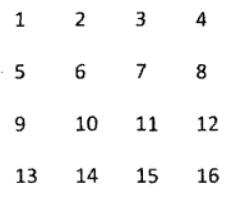劍指offer-19、順時針打印矩陣
題?描述
輸??個矩陣,按照從外向?以順時針的順序依次打印出每?個數(shù)字,例如,如果輸?如下4 X 4 矩陣:

則依次打印出數(shù)字 1,2,3,4,8,12,16,15,14,13,9,5,6,7,11,10 .
思路及解答
邊界收縮法(推薦)
我們使?的是不斷縮?矩陣上,下,左,右四個邊界的?法。?先定義?個up (上邊界為0 ), down (下邊界為matrix.length - 1 ), left (左邊界為0 ), right (右邊界為matrix[0].length - 1 )。
從第?個?第?個開始打印,向左邊界遍歷到右邊界,之后將上邊界加上1 (因為已經(jīng)遍歷完成上邊界??),判斷上邊界加上?之后是否?于下邊界,如果是則調(diào)出。
之后執(zhí)?類型操作,從上到下,從右到左,從下到上。

具體思路如下:
- 定義四個邊界:上(up)、下(down)、左(left)、右(right)
- 按照順時針方向遍歷當前層:
- 從左到右遍歷上邊界
- 從上到下遍歷右邊界
- 從右到左遍歷下邊界
- 從下到上遍歷左邊界
- 遍歷完一層后,收縮邊界進入下一層
public class Solution {
public ArrayList<Integer> printMatrix(int[][] matrix) {
ArrayList<Integer> results = new ArrayList();
if (matrix != null && matrix.length > 0) {
int left = 0;
int right = matrix[0].length - 1;
int up = 0;
int down = matrix.length - 1;
int i;
while (true) {
for (i = left; i <= right; i++) {
results.add(matrix[up][i]);
}
if ((++up) > down) {
break;
}
for (i = up; i <= down; i++) {
results.add(matrix[i][right]);
}
if (--right < left) {
break;
}
for(i=right;i>=left;i--){
results.add(matrix[down][i]);
}
if(--down<up){
break;
}
for(i=down;i>=up;i--){
results.add(matrix[i][left]);
}
if(++left>right){
break;
}
}
}
return results;
}
}
注意: (++up) > down 代表 up=up+1;up>dowm 兩個語句。
- 時間復雜度?:O(mn),每個元素被訪問一次
- 空間復雜度?:O(1),除了輸出結(jié)果外只使用了固定數(shù)量的變量
方向模擬法
模擬順時針移動的路徑,按照右→下→左→上的方向順序遍歷:
- 定義四個方向向量表示移動方向
- 使用一個二維數(shù)組記錄已訪問的位置
- 當遇到邊界或已訪問的位置時,順時針旋轉(zhuǎn)方向
public List<Integer> printMatrix(int[][] matrix) {
List<Integer> result = new ArrayList<>();
if (matrix == null || matrix.length == 0) return result;
int rows = matrix.length, cols = matrix[0].length;
boolean[][] visited = new boolean[rows][cols];
int[][] directions = {{0, 1}, {1, 0}, {0, -1}, {-1, 0}};
int directionIndex = 0;
int row = 0, col = 0;
for (int i = 0; i < rows * cols; i++) {
result.add(matrix[row][col]);
visited[row][col] = true;
int nextRow = row + directions[directionIndex][0];
int nextCol = col + directions[directionIndex][1];
if (nextRow < 0 || nextRow >= rows || nextCol < 0 || nextCol >= cols
|| visited[nextRow][nextCol]) {
directionIndex = (directionIndex + 1) % 4;
}
row += directions[directionIndex][0];
col += directions[directionIndex][1];
}
return result;
}
- 時間復雜度?:O(mn)
- ?空間復雜度?:O(mn),需要額外的visited數(shù)組
遞歸分解法
將矩陣分解為外層和內(nèi)層,遞歸處理:
- 遍歷當前矩陣的最外層
- 將剩余部分作為新矩陣遞歸處理
- 遞歸終止條件:矩陣為空或只剩一行/一列
public List<Integer> printMatrix(int[][] matrix) {
List<Integer> result = new ArrayList<>();
if (matrix == null || matrix.length == 0) return result;
spiralHelper(matrix, 0, matrix.length - 1, 0, matrix[0].length - 1, result);
return result;
}
private void spiralHelper(int[][] matrix, int top, int bottom, int left, int right, List<Integer> result) {
if (left > right || top > bottom) return;
// 遍歷上邊
for (int i = left; i <= right; i++) {
result.add(matrix[top][i]);
}
// 遍歷右邊
for (int i = top + 1; i <= bottom; i++) {
result.add(matrix[i][right]);
}
if (top < bottom && left < right) { // 防止單行或單列
// 遍歷下邊
for (int i = right - 1; i >= left; i--) {
result.add(matrix[bottom][i]);
}
// 遍歷左邊
for (int i = bottom - 1; i > top; i--) {
result.add(matrix[i][left]);
}
}
// 遞歸處理內(nèi)層
spiralHelper(matrix, top + 1, bottom - 1, left + 1, right - 1, result);
}
- 時間復雜度?:O(mn)
- ?空間復雜度?:O(min(m,n)),遞歸棧的深度
本文來自在線網(wǎng)站:seven的菜鳥成長之路,作者:seven,轉(zhuǎn)載請注明原文鏈接:www.seven97.top


 浙公網(wǎng)安備 33010602011771號
浙公網(wǎng)安備 33010602011771號